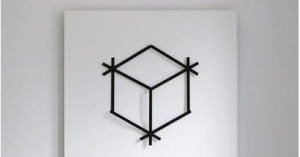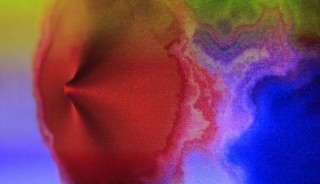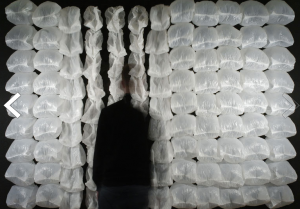Looking Outwards 3, Claire
Soak, Dye in Light, everyware
“’Soak, Dye in light.’ by everyware (2011) is an empty canvas but when you touch it, its elastic surface stretches and gets suffused with projected vivid colors mimicking fabric absorbing dye. Poking and rubbing with hands or resting their body on this spandex canvas allows visitors to soak this canvas in virtual dye and create own patterns.
Dying fabric is a time-honored tradition of humankind. Local materials such as herbs, flowers, rocks, juice of animals or shells have been used through the dying process. Especially in Korea, people have deep affection toward the unique colors and textures of fabric dyed with traditional materials. Now in the age of new media, we tried a whole new way of coloring fabrics with the essential materials of new media, ‘light’ and ‘interactivity’. Also, as a meta-creative interactive installation, ‘Soak’ can be expanded for creating garments with personalized patterns or textile productions using today’s digital fabric printing technologies.”
I found the integration of old-time aesthetics with new-age technology to be particularly relevant. While the progress of visual discourse is of course interesting, there is something very tactile about this work. The combination of contemporary practice with historical style is seamlessly fused in this work, and, to me, it is this balance that creates interest.
One Perfect Cube, Florian Jenett

In this piece, Florian Jenett has created a series of three clocks which “form a sign every 12 hours for exactly one second.” (florianjenett.de) It is a complex system which aligns all the clocks and allows the cube moment to occur. “To be able to try different symbols and texts to embed into “One Perfect Cube” a custom layout software was built in Processing. It allows one to freely place, scale and adjust time on a multitude of clocks. Every time a clock is added or changed the software would check for possible collisions between the clocks and would arrange the clocks on different yet as few as possible layers to allow the hands of two clocks to pass one another. A virtual master clock can be used to test the sculpture at different times.”
While this piece is quite simple aesthetically, I think it is an elegant concept and an interesting application of processing outside of purely web-based work.
One Hundred and Eight, Nils Völker
Controlled by an Arduino and Processing, Nils Völker created an installation with wall-mounted plastic bags which respond to the location of the viewer. Each of the bags is selectively inflated and deflated in turn by cooling fans, creating a fluid organic motion. When the viewer enters the space, the bags draw back and respond more tentatively to his or her motions.
The simplicity an elegance of this piece is perhaps the most interesting element. The way that something a simple as application of a fan can transform something like a plastic bag into an organic element is compelling. Furthermore, I have become more interested in real-world applications of processing and other methods of programming that we will learn in this class. I am not particularly interested in purely computer-based work, however the application of the skillset that we are learning into interactive installation feel like something that could potentially become a part of my practice.

